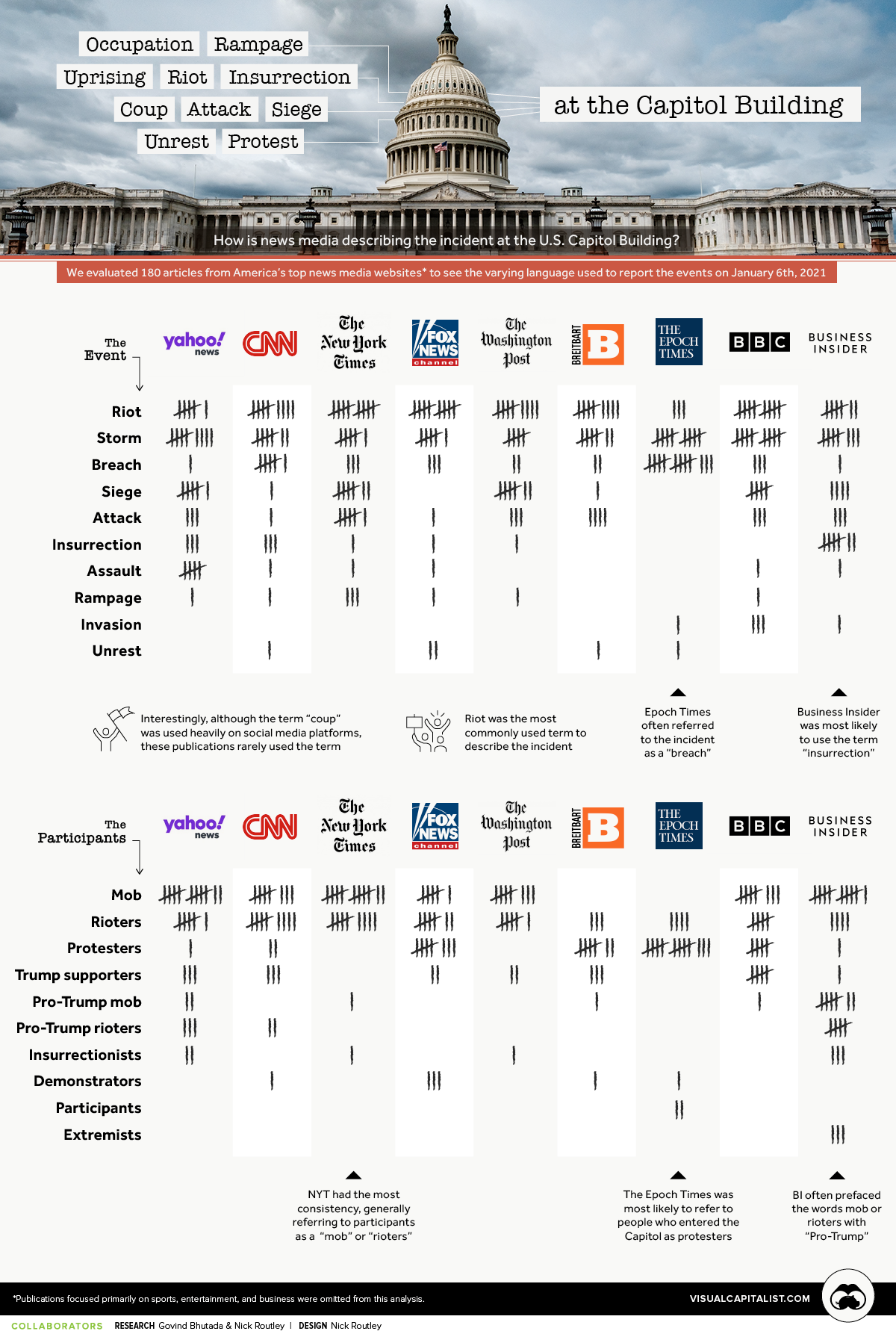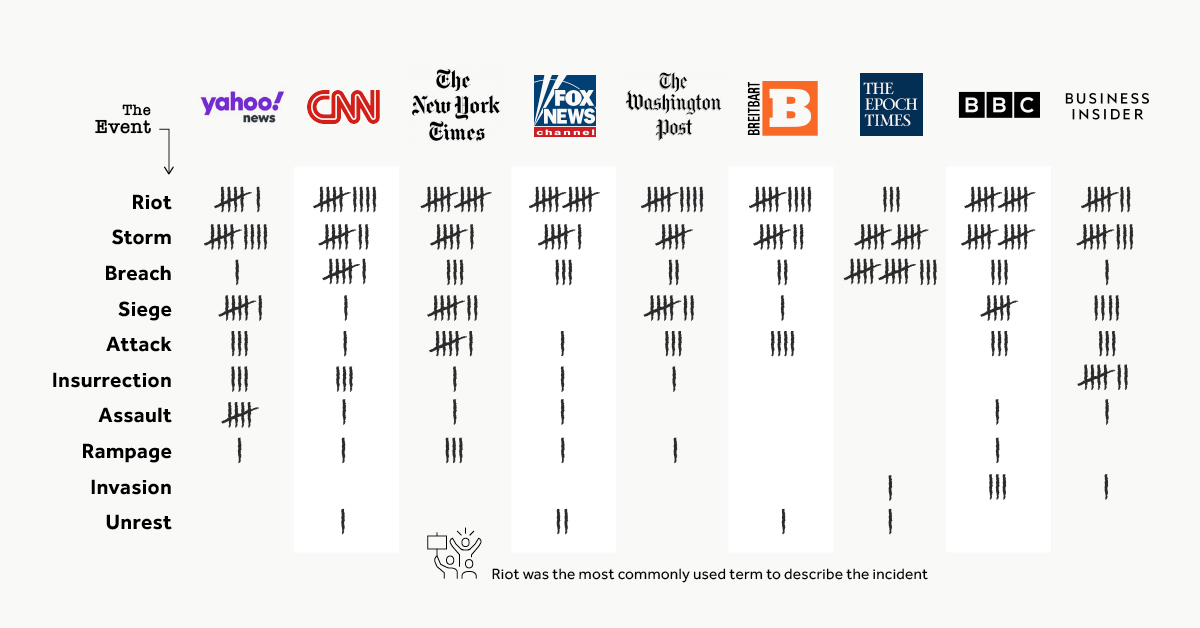Politics
How News Media is Describing the Incident at the U.S. Capitol

How Media Outlets Describe the Incident at the U.S. Capitol
Was it a riot? An insurrection? Or was it simply a protest?
The January 6, 2021 incident at the U.S. Capitol was widely covered in news media—however, the type of language used to describe it varied greatly from publication to publication.
Popular news media has a major impact on how society at large perceives major events. To learn more about the language used in recent coverage, we analyzed over 180 articles from Alexa’s top-ranked news websites in the United States. Here’s what we found.
Most Common Descriptions: The Event
From riot to rampage, descriptions used by news media of the incident at the U.S. Capitol were all over the map:
| ↓ Event descriptor | Yahoo | CNN | NYT | Fox | WaPo | Breitbart | Epoch Times | BBC | BI |
|---|---|---|---|---|---|---|---|---|---|
| Riot | 6 | 9 | 9 | 10 | 9 | 9 | 3 | 10 | 7 |
| Storm | 9 | 7 | 6 | 6 | 5 | 7 | 10 | 10 | 8 |
| Breach | 4 | 6 | 3 | 3 | 2 | 2 | 13 | 3 | 1 |
| Siege | 6 | 1 | 7 | 7 | 1 | 5 | 4 | ||
| Attack | 3 | 1 | 6 | 1 | 3 | 4 | 3 | 3 | |
| Insurrection | 3 | 3 | 1 | 1 | 1 | 7 | |||
| Assault | 5 | 1 | 1 | 1 | 1 | 1 | |||
| Rampage | 1 | 1 | 3 | 1 | 1 | 1 | |||
| Invasion | 1 | 3 | 1 | ||||||
| Unrest | 1 | 2 | 1 | 1 |
The most commonly used description was riot, followed by storm. On the other end of the spectrum were the less-frequent terms such as insurrection, assault, rampage, and invasion.
Interestingly, Yahoo News, Business Insider, and BBC used siege, attack, and insurrection more often as compared to Breitbart, Epoch Times, and Fox News. The Epoch Times also described the event as a breach more times than any other outlet.
Most Common Descriptions: The Participants
The participants in the incident were identified in various ways, reflecting the variation seen in describing the incident.
| ↓ Participants | Yahoo | CNN | NYT | Fox | WaPo | Breitbart | Epoch Times | BBC | BI |
|---|---|---|---|---|---|---|---|---|---|
| Mob | 12 | 8 | 12 | 6 | 8 | 8 | 11 | ||
| Rioters | 6 | 9 | 9 | 7 | 6 | 3 | 4 | 5 | 4 |
| Protesters | 1 | 2 | 8 | 7 | 13 | 5 | 1 | ||
| Trump supporters | 3 | 3 | 2 | 2 | 3 | 5 | 1 | ||
| Pro-Trump mob | 2 | 1 | 1 | 1 | 7 | ||||
| Pro-Trump rioters | 3 | 2 | 5 | ||||||
| Insurrectionists | 2 | 1 | 1 | 3 | |||||
| Demonstrators | 1 | 3 | 1 | 1 | |||||
| Participants | 2 | ||||||||
| Extremists | 3 |
In alignment with the usage of riot, the most common descriptions for participants were mob and rioters, followed by protesters. The frequency of use of Trump supporters comes as no surprise, especially since many of the participants are known to have attended the ‘Stop the Steal’ Trump rally preceding the event.
While most outlets referred to the crowd as protesters in the events leading up to the storming of the Capitol building, not all used that term to describe the people who entered the Capitol building. Fox News, Breitbart, and Epoch Times used protesters more often than any other news media outlet. In fact, these three outlets account for 28 of the 37 news articles in which the term protesters appeared.
On the other hand, the term pro-Trump rioters—which was used by Yahoo News, Business Insider, and CNN—did not appear in any articles by Fox News, Breitbart, or Epoch Times.
Tonal Differences
While some media outlets stuck to relatively neutral descriptors, others used unconventional terms to describe both the incident as well as those involved.
The New York Times and the Washington Post, for example, generally adhered to neutral language. They frequently described the event as a siege and a riot, and those involved as the mob and rioters.

The Epoch Times and Breitbart employed terms like protesters and alleged Trump supporters in discussing the individuals involved.

On the other hand, Yahoo News called it an insurrection carried out by militant supporters of President Trump, and Business Insider talked of a pro-Trump assault on the U.S. Capitol.

The British Broadcasting Company (BBC) potentially reflects how the event was perceived outside of the United States. Terms like riot and stormed appeared most commonly in BBC coverage of the incident. The participants were evenly identified as rioters, Trump supporters, protesters, and more often as the mob.

The Impact of Media Coverage
The influence of news media on how the public perceives events is undeniable. In fact, 88% of surveyed Americans consider the news an essential tool to keep informed about public affairs.
From a riot caused by rioters to an insurrection by President Trump’s militant supporters, the way different media outlets analyze the U.S. Capitol incident impacts what their respective audiences take away from it.
Note: Publications that focus primarily on sports, entertainment, and business were omitted from this analysis. We analyzed 20 articles from each publication that related directly to the Capitol situation and resulting coverage.
Economy
The Bloc Effect: International Trade with Geopolitical Allies on the Rise
Rising geopolitical tensions are shaping the future of international trade, but what is the effect on trading among G7 and BRICS countries?

The Bloc Effect: International Trade with Allies on the Rise
International trade has become increasingly fragmented over the last five years as countries have shifted to trading more with their geopolitical allies.
This graphic from The Hinrich Foundation, the first in a three-part series covering the future of trade, provides visual context to the growing divide in trade in G7 and pre-expansion BRICS countries, which are used as proxies for geopolitical blocs.
Trade Shifts in G7 and BRICS Countries
This analysis uses IMF data to examine differences in shares of exports within and between trading blocs from 2018 to 2023. For example, we looked at the percentage of China’s exports with other BRICS members as well as with G7 members to see how these proportions shifted in percentage points (pp) over time.
Countries traded nearly $270 billion more with allies in 2023 compared to 2018. This shift came at the expense of trade with rival blocs, which saw a decline of $314 billion.
Country Change in Exports Within Bloc (pp) Change in Exports With Other Bloc (pp)
🇮🇳 India 0.0 3.9
🇷🇺 Russia 0.7 -3.8
🇮🇹 Italy 0.8 -0.7
🇨🇦 Canada 0.9 -0.7
🇫🇷 France 1.0 -1.1
🇪🇺 EU 1.1 -1.5
🇩🇪 Germany 1.4 -2.1
🇿🇦 South Africa 1.5 1.5
🇺🇸 U.S. 1.6 -0.4
🇯🇵 Japan 2.0 -1.7
🇨🇳 China 2.1 -5.2
🇧🇷 Brazil 3.7 -3.3
🇬🇧 UK 10.2 0.5
All shifts reported are in percentage points. For example, the EU saw its share of exports to G7 countries rise from 74.3% in 2018 to 75.4% in 2023, which equates to a 1.1 percentage point increase.
The UK saw the largest uptick in trading with other countries within the G7 (+10.2 percentage points), namely the EU, as the post-Brexit trade slump to the region recovered.
Meanwhile, the U.S.-China trade dispute caused China’s share of exports to the G7 to fall by 5.2 percentage points from 2018 to 2023, the largest decline in our sample set. In fact, partly as a result of the conflict, the U.S. has by far the highest number of harmful tariffs in place.
The Russia-Ukraine War and ensuing sanctions by the West contributed to Russia’s share of exports to the G7 falling by 3.8 percentage points over the same timeframe.
India, South Africa, and the UK bucked the trend and continued to witness advances in exports with the opposing bloc.
Average Trade Shifts of G7 and BRICS Blocs
Though results varied significantly on a country-by-country basis, the broader trend towards favoring geopolitical allies in international trade is clear.
Bloc Change in Exports Within Bloc (pp) Change in Exports With Other Bloc (pp)
Average 2.1 -1.1
BRICS 1.6 -1.4
G7 incl. EU 2.4 -1.0
Overall, BRICS countries saw a larger shift away from exports with the other bloc, while for G7 countries the shift within their own bloc was more pronounced. This implies that though BRICS countries are trading less with the G7, they are relying more on trade partners outside their bloc to make up for the lost G7 share.
A Global Shift in International Trade and Geopolitical Proximity
The movement towards strengthening trade relations based on geopolitical proximity is a global trend.
The United Nations categorizes countries along a scale of geopolitical proximity based on UN voting records.
According to the organization’s analysis, international trade between geopolitically close countries rose from the first quarter of 2022 (when Russia first invaded Ukraine) to the third quarter of 2023 by over 6%. Conversely, trade with geopolitically distant countries declined.
The second piece in this series will explore China’s gradual move away from using the U.S. dollar in trade settlements.

Visit the Hinrich Foundation to learn more about the future of geopolitical trade

-

 Economy3 days ago
Economy3 days agoEconomic Growth Forecasts for G7 and BRICS Countries in 2024
The IMF has released its economic growth forecasts for 2024. How do the G7 and BRICS countries compare?
-

 United States2 weeks ago
United States2 weeks agoRanked: The Largest U.S. Corporations by Number of Employees
We visualized the top U.S. companies by employees, revealing the massive scale of retailers like Walmart, Target, and Home Depot.
-

 Economy2 weeks ago
Economy2 weeks agoWhere U.S. Inflation Hit the Hardest in March 2024
We visualized product categories that saw the highest % increase in price due to U.S. inflation as of March 2024.
-

 Economy1 month ago
Economy1 month agoG20 Inflation Rates: Feb 2024 vs COVID Peak
We visualize inflation rates across G20 countries as of Feb 2024, in the context of their COVID-19 pandemic peak.
-

 Economy1 month ago
Economy1 month agoMapped: Unemployment Claims by State
This visual heatmap of unemployment claims by state highlights New York, California, and Alaska leading the country by a wide margin.
-

 Economy2 months ago
Economy2 months agoConfidence in the Global Economy, by Country
Will the global economy be stronger in 2024 than in 2023?
-

 Debt1 week ago
Debt1 week agoHow Debt-to-GDP Ratios Have Changed Since 2000
-

 Markets2 weeks ago
Markets2 weeks agoRanked: The World’s Top Flight Routes, by Revenue
-

 Demographics2 weeks ago
Demographics2 weeks agoPopulation Projections: The World’s 6 Largest Countries in 2075
-

 Markets2 weeks ago
Markets2 weeks agoThe Top 10 States by Real GDP Growth in 2023
-

 Demographics2 weeks ago
Demographics2 weeks agoThe Smallest Gender Wage Gaps in OECD Countries
-

 Economy2 weeks ago
Economy2 weeks agoWhere U.S. Inflation Hit the Hardest in March 2024
-

 Green2 weeks ago
Green2 weeks agoTop Countries By Forest Growth Since 2001
-

 United States2 weeks ago
United States2 weeks agoRanked: The Largest U.S. Corporations by Number of Employees















